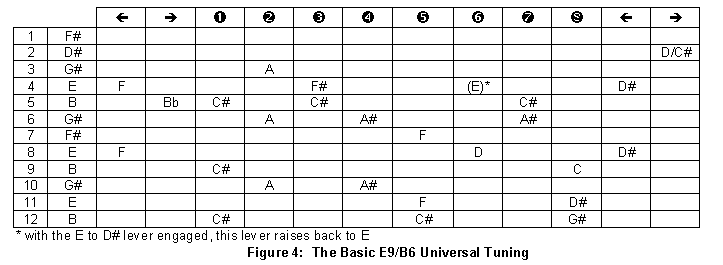The E9/B6 Universal Tuning
I was intrigued early on by the principle of a single tuning that was able to attain the vast majority of the chord voicings and tone movements found on the traditional E9 and C6 tunings. It clearly COULD be done, but I wondered whether the guitar/mechanism could handle it, and whether it would be tunable and playable. I had talked to Maurice Anderson about his Bb6/Eb9 tuning and had decided to raise it 1/2 step and use the 9th tuning as the open tuning. I will describe some of my early escapades below ---(coming soon).
It is noteworthy that several folks seemed to have been developing this universal, 'common denominator' tuning from 1975 until 1977 when John Helak published the same tuning that Jeff Newman has taught (and uses) and made popular in the PSGA Newsletter. Great articles. He went at it by dropping C6 to B6 -- writing out the chart and adding the upper E9 strings to develop a 13 string universal tuning. Since 13 stringers are rare, he developed 12- and 14-string variations. I understand that Jan Visser, in the Netherlands, was doing something very similar in that time frame. Winnie Winston was using a 13-string version, with the D on 9, when his "Pedal Steel Guitar" book was published in 1975 and Bill Keith was using a similar setup. Winnie Winston may well have been the first player to use a tuning that includes all the features (if not all the changes) of the universal taught by Jeff Newman and sold by Carter and others.
Maurice has written a very informative summary of the relationship between his universal tuning concept and the evolution of pedal steel guitar. You may see it by clicking here. (Thanks to Bobby Lee for making this excellent historical document available) I believe that once the principle of getting the tonal combinations that are available on both necks of a 'standard' D-10 is formulated (which Maurice did in the mid 1970s), according to his article, it makes no difference whether you tune to the 9th or the 6th or play in E9/B6 or Bb6/Eb9, it's all the same tuning and pedal changes.
The C6 pedals are more or less based on the I-IV and I-VI-II chord movements, like in western swing -- where the C6 tuning came from. The I chord is usually the Ma7(or 9) or 6th and the IV chord is usually a Dominant 7th or 9th. So in C you'd get C6, F9 (the I and IV) and C6, A7, D7. Most of the standard pedal/lever changes on C6 are the basic functions. The E9/B6 universal duplicates all those functions in a key (B) that is related to the key of the open tuning (E). This makes using the 6th changes in a 9th tuning context and vice versa possible in a way that is not possible on a double neck.
From the E9 context, raising the 9th string from B to D gives strings 1-9 of the E9 tuning. If you don't need the D (b7), the 9th string is the same as the 10th string on standard E9. Including some or all of the A, B, and C pedal changes into the lower octave allows some interesting extensions of common country phrases into a lower voicing.
(There is more info below. I will complete the derivation and historical discussion when time allows)
Examples of Universal Setups
The Rationale Behind the Universal Tuning
Derivation of E9/B6 from Maurice Anderson's Bb6 Universal
My History with E9/B6
